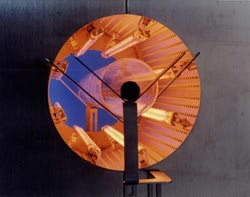This special field revolves around processes for modifying material properties (milling, cooling), composition (filtration, distillation) and type (oxidation, hydration).
Valuable information is available on a broad range of technologies including material separation, laser processes, measuring techniques and robot engineering in addition to testing methods and coating and materials analysis processes.

Heraeus at the plastics industry`s trade fair K in Düsseldorf – Infrared emitters for every application
In the plastics industry today, when extruding foil, forming PET bottles, riveting automotive interior panels, drying the print on yoghurt cups, or sealing tank containers, an increasingly important tool is the unique source of heat known as infrared radiation. Heraeus Noblelight is known for its innovative product development and application of infrared heat systems. The co

Following on from the success of EUREKA project E! 2534 THERMOPOLE, which developed thermoplastic lampposts that save lives by bending on impact, EUREKA project E! 2535 FACTORY PANELFORM has adapted the thermoplastic technology to produce sandwich section panels for a market worth over €20 million a year.
The recyclable panels can be produced in three-metre wide sections at a rate of four metres per minute, in a variety of colours and finishes. The new material is stronger and more

A team of University of Florida researchers has invented a way to rapidly detect traces of TNT or other hidden explosives simply by shining a light on any potentially contaminated object, from a speck of dust in the air to the surface of a suitcase. “We have to find explosives quickly, inexpensively and, particularly, reliably,” said Rolf Hummel, a UF professor emeritus of materials science and engineering who heads the lab where the method was invented.
The development provides in

ULIS SAS of France, a European leader in the field of low-cost infrared detectors for thermal imagery, has launched its latest, third-generation, uncooled 160×120 pixels microbolometer detector – the UL 02 05 1 – which operates at room temperature. The low cost of the device is one of its strongest selling points. By dividing the price of the system by three or even by four through the use of innovative microbolometers, ULIS has made infrared imagery available to markets such as industrial survei

Coatings used to protect the exposed wooden parts of buildings have to withstand all kinds of weather. To avoid over-frequent renovation, architects, builders and house-owners are advised to look for a reliable quality label. The relevant European standard is being revised.
A weather-beaten mountain chalet might look charming – but assaults by heat and cold, rain and sunshine, will eventually destroy even highly weather-resistant timber like larch. Outdoor paint or varnish is expecte

EUREKA project E! 2007 FACTORY PACK 2000 developed much more than a new packaging process for large items such as furniture and stone flooring. The system includes an advanced vision system, uses only one recyclable packaging material, offers additional environmental benefits by using less material and producing less waste – and is set to generate a 30% increase in turnover for the Italian lead partner, Aetna.
The project initially developed a new recyclable plastic packaging materi